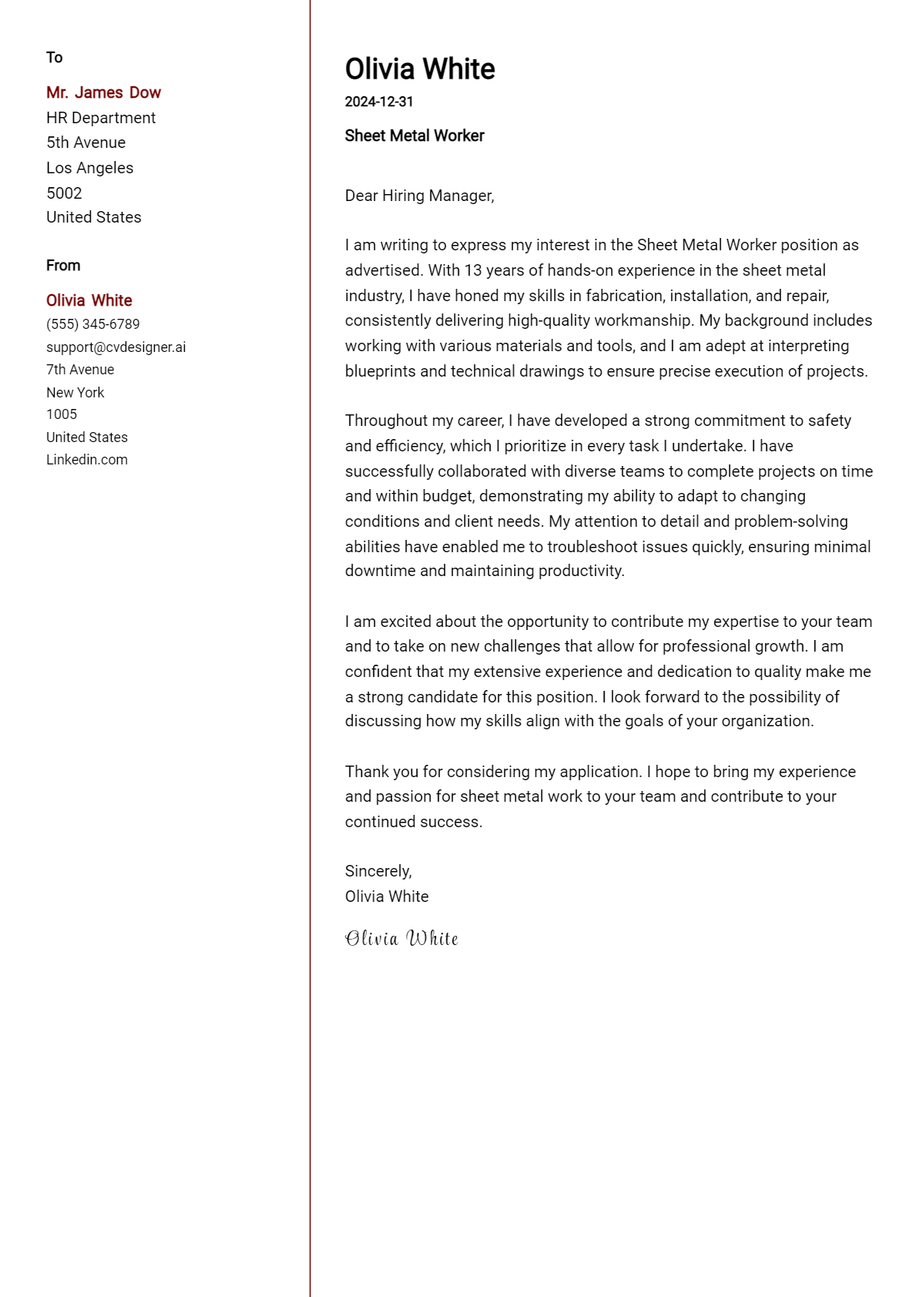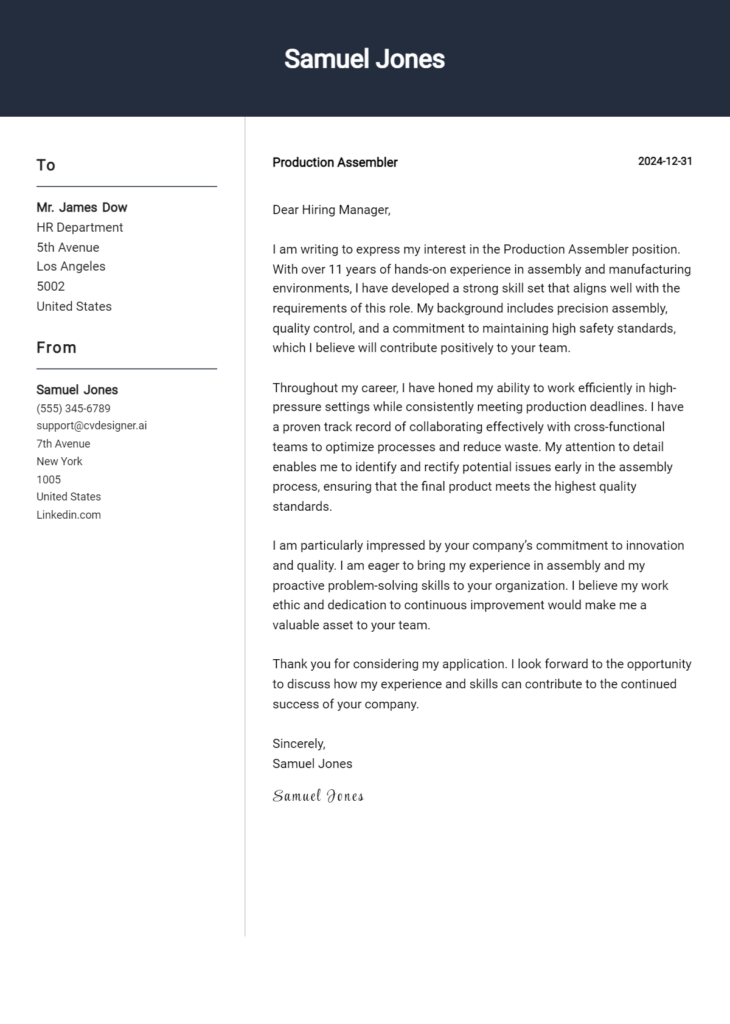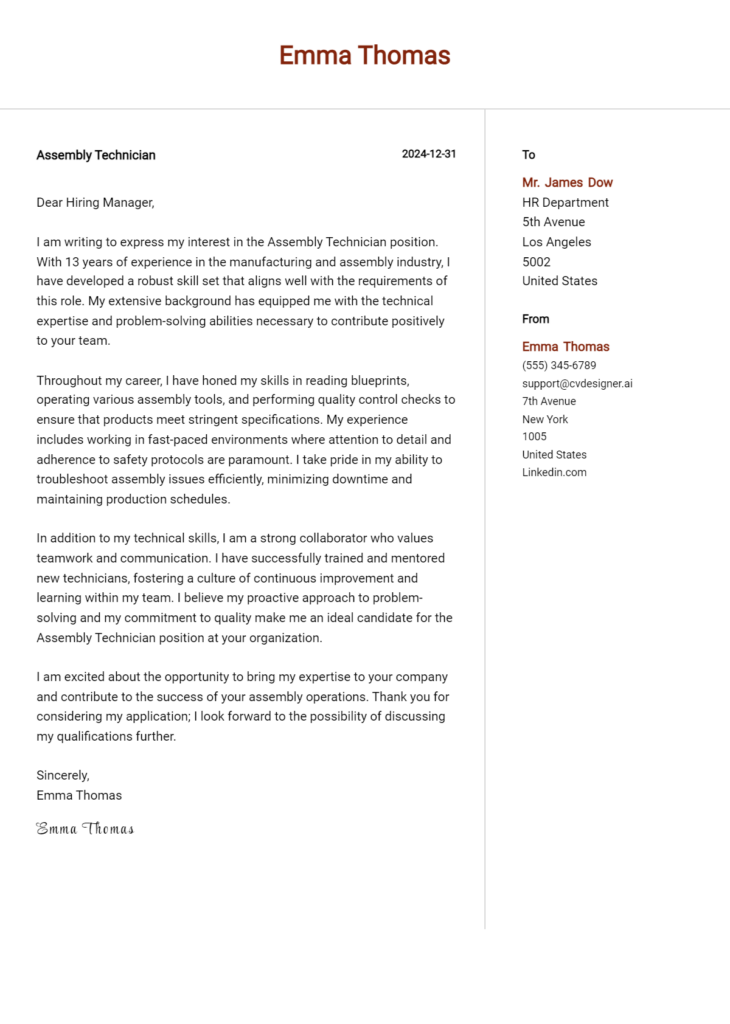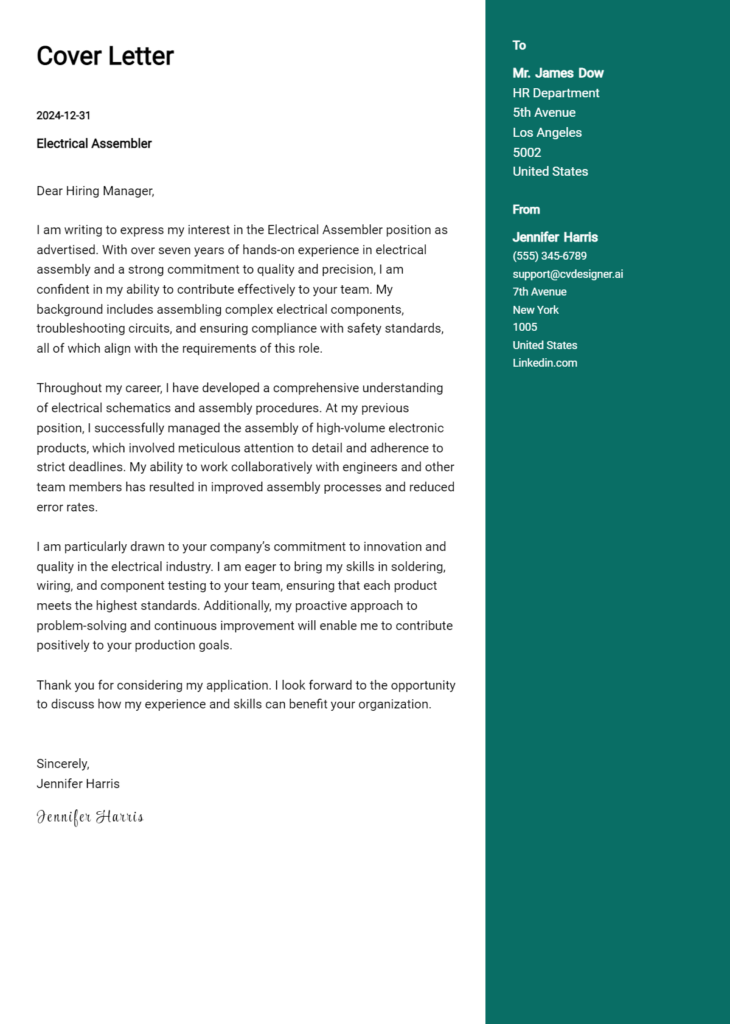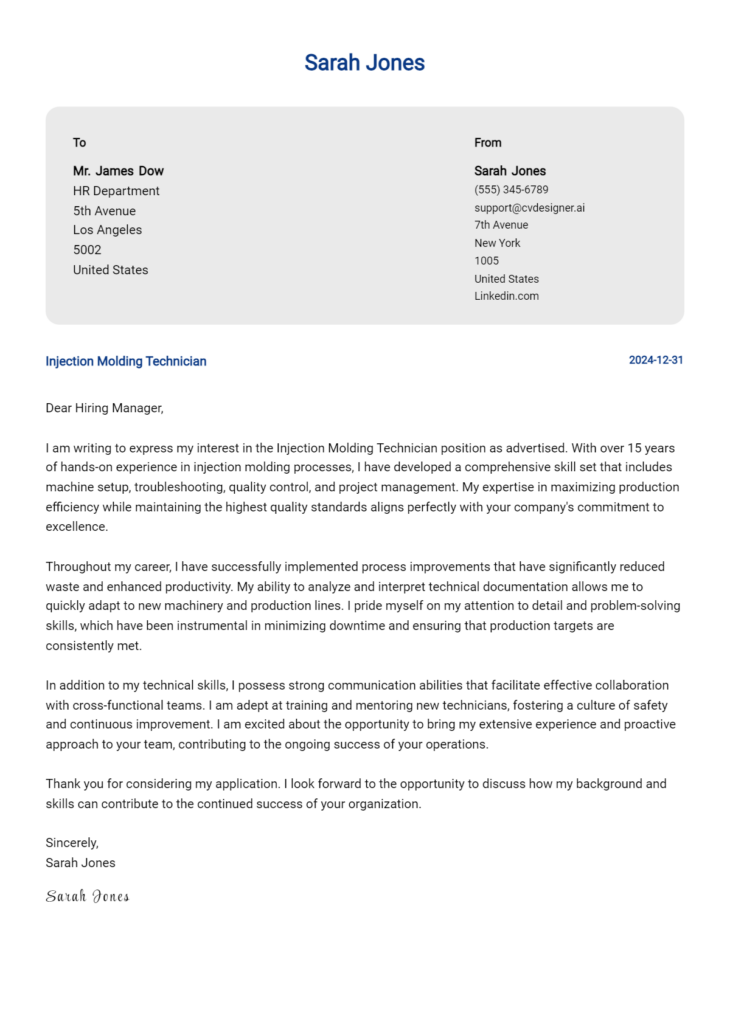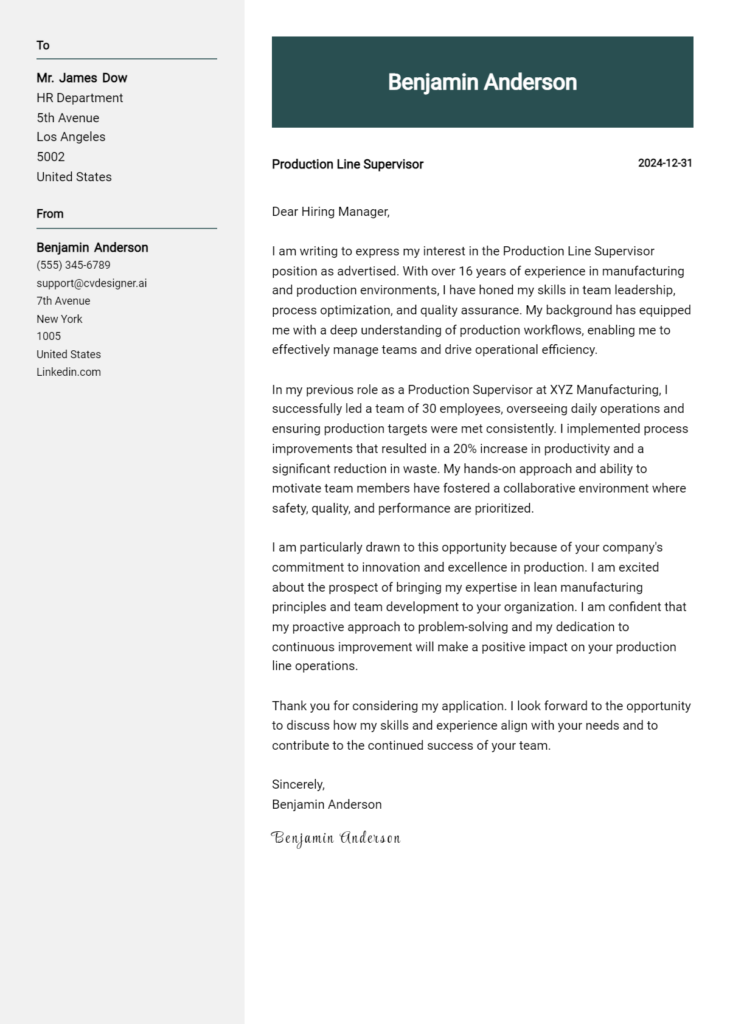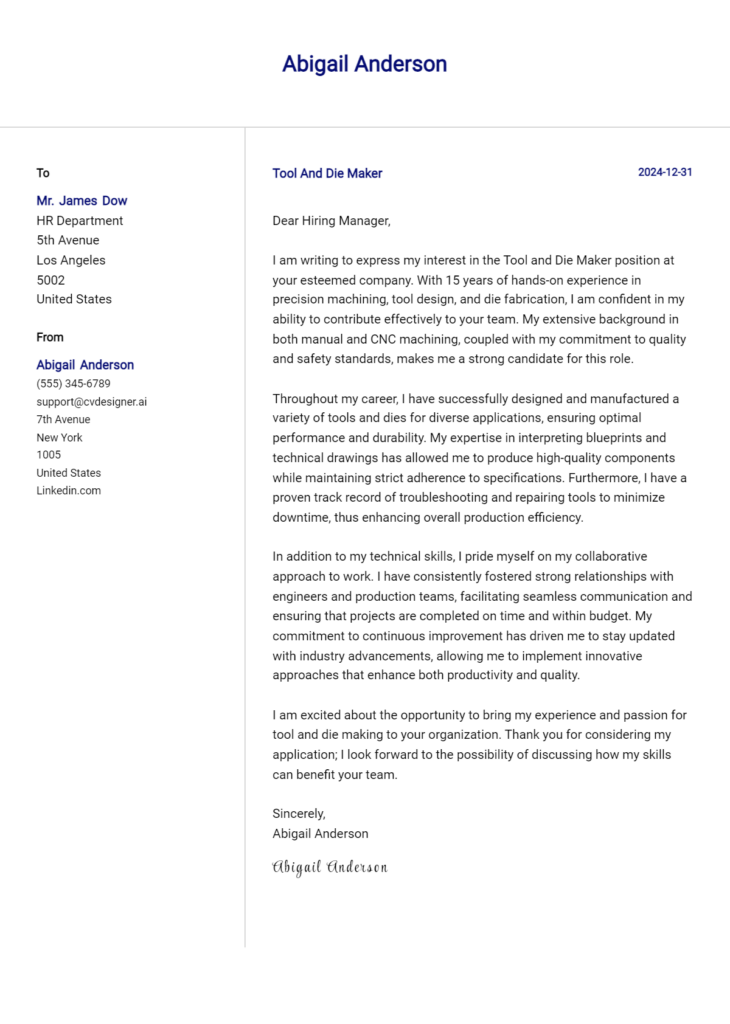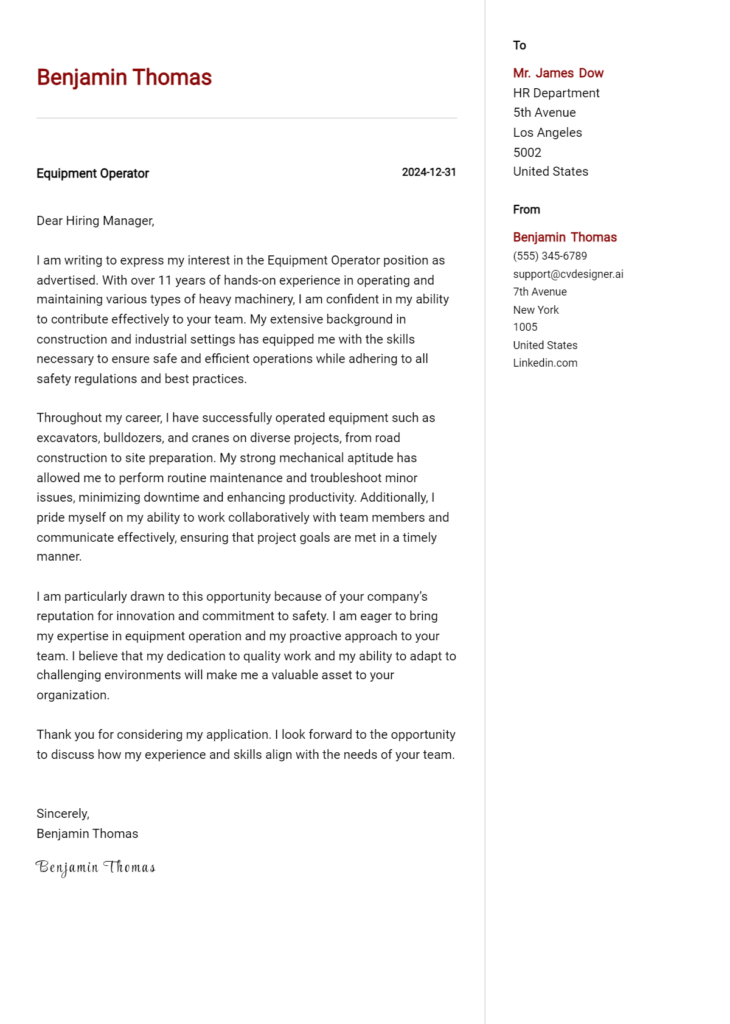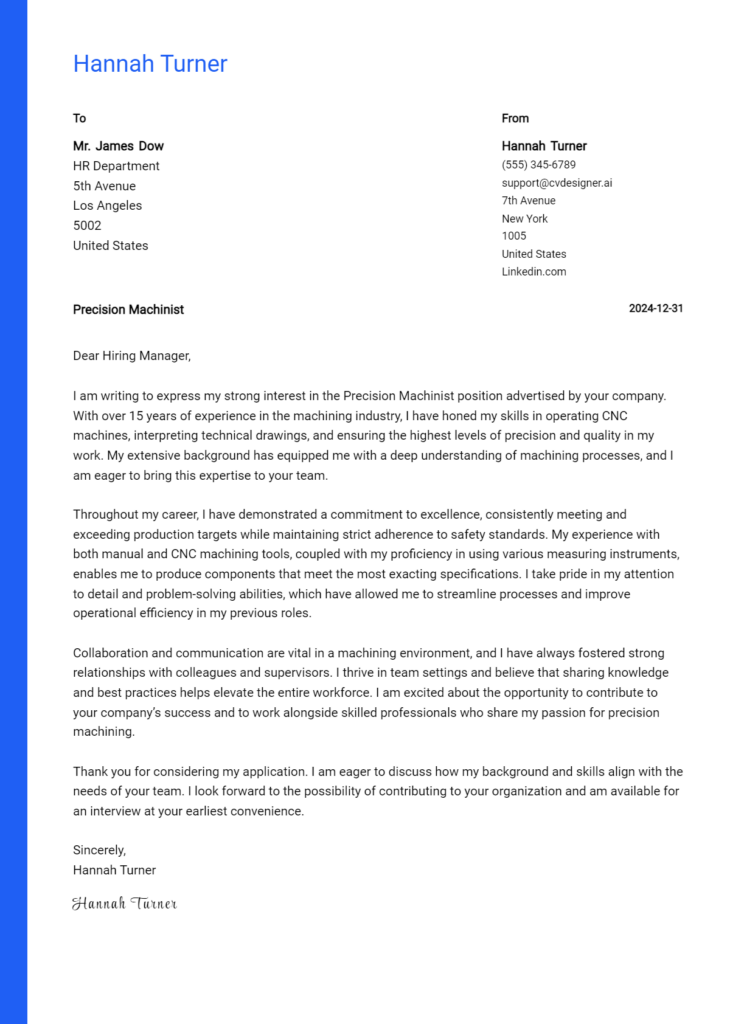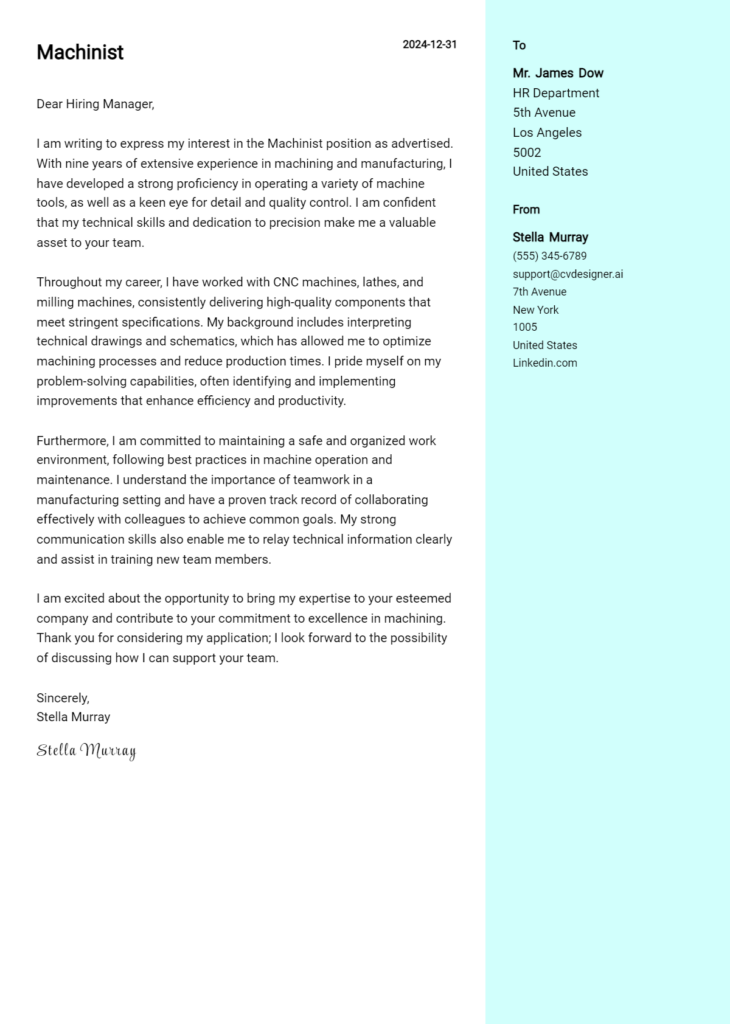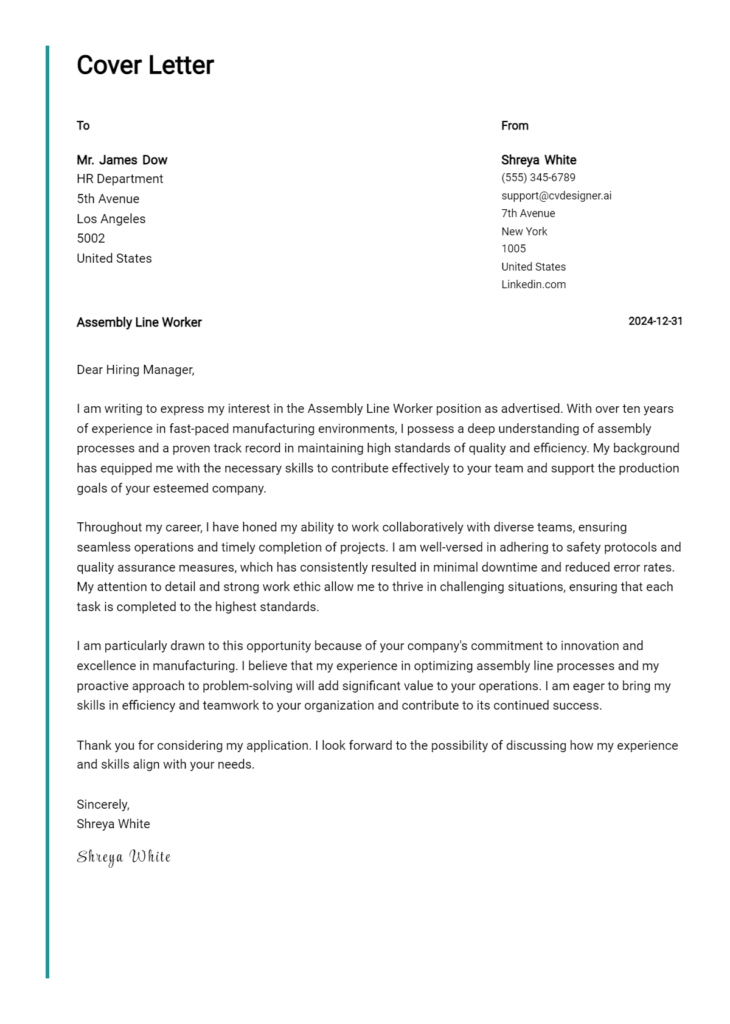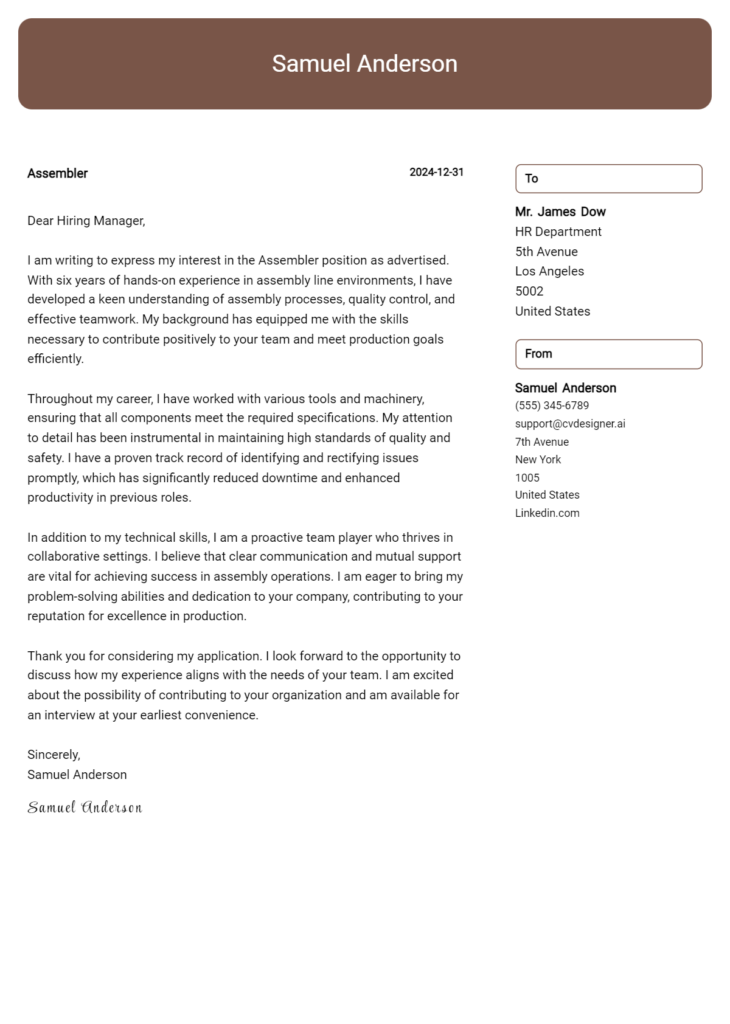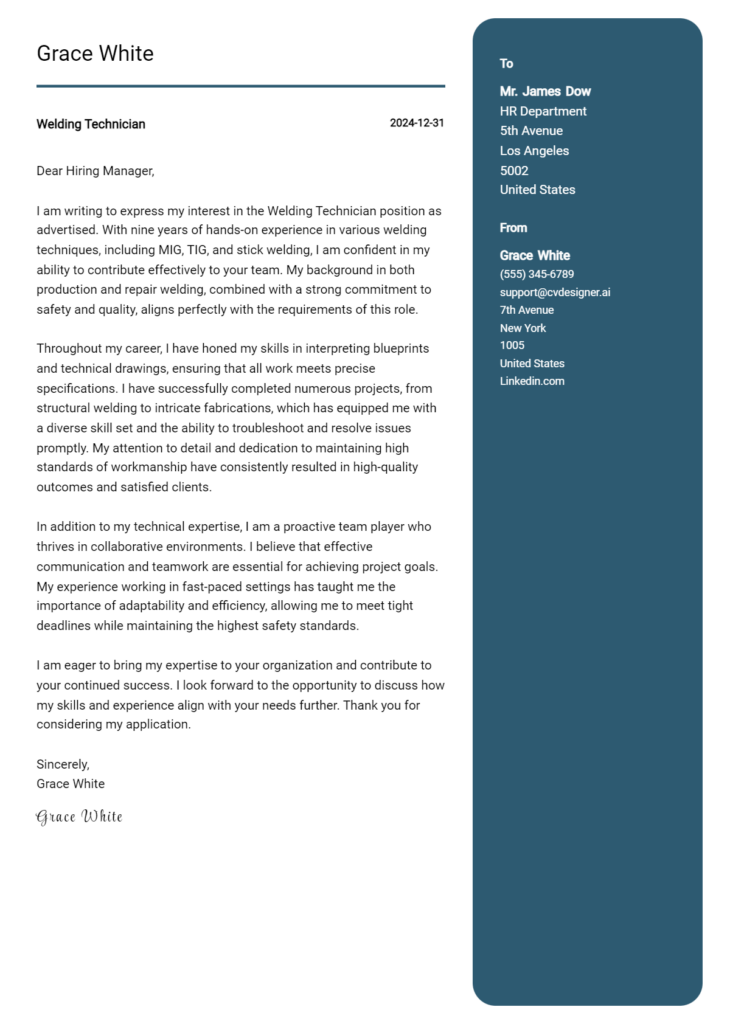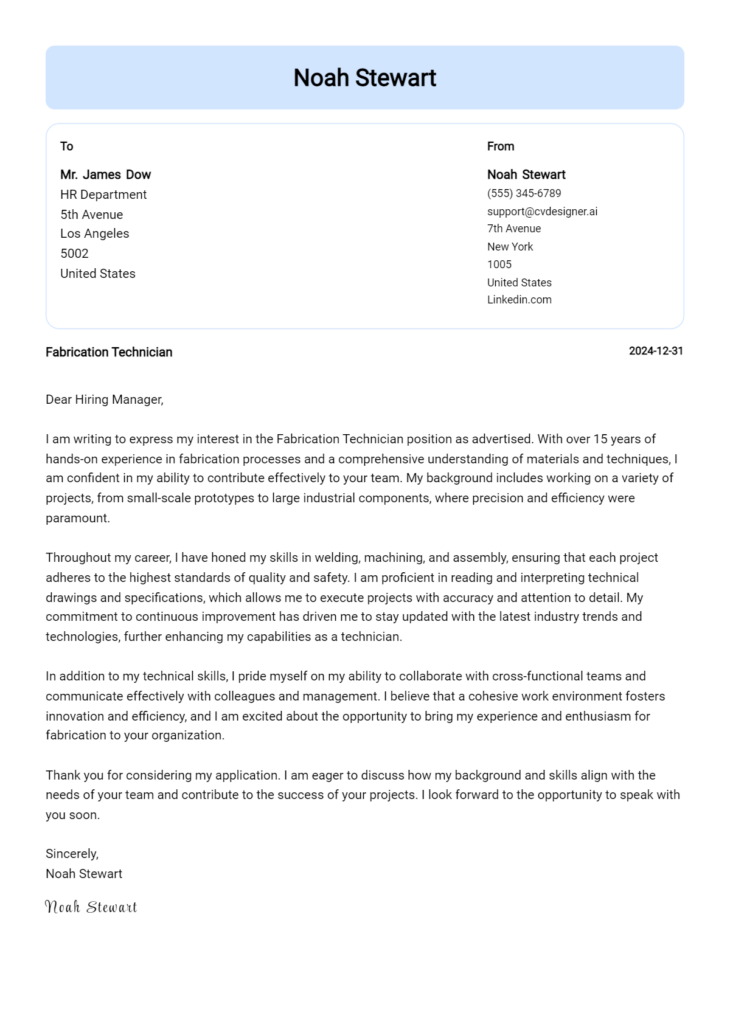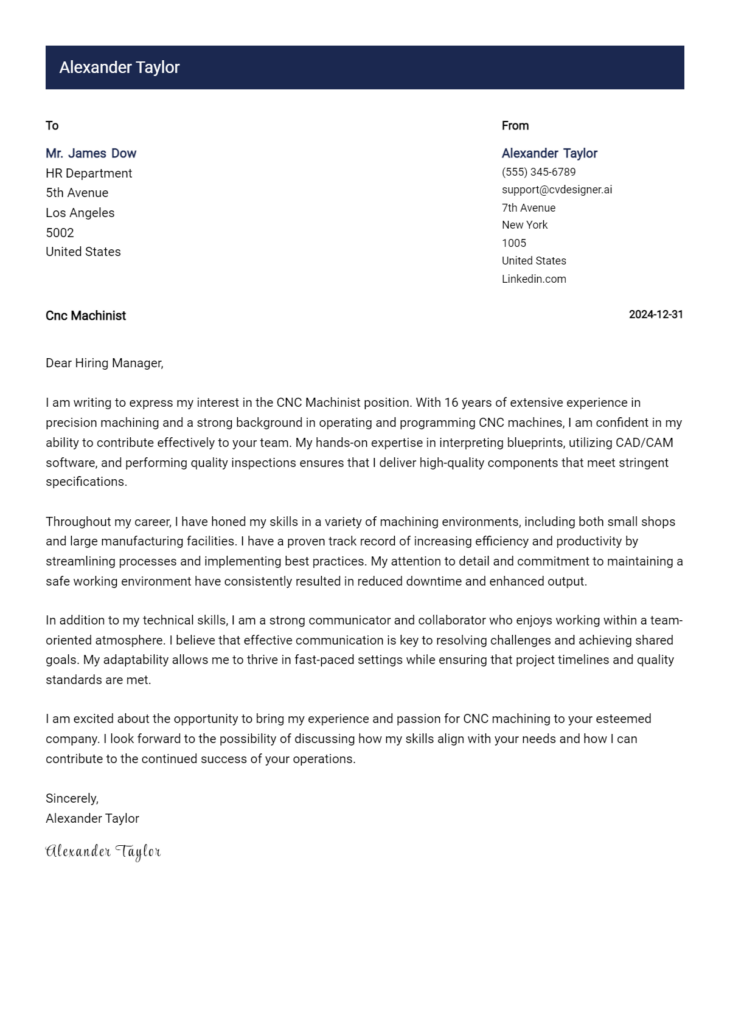Sheet Metal Worker Cover Letter Examples
Explore additional Sheet Metal Worker cover letter samples and guides and see what works for your level of experience or role.
How to Format a Sheet Metal Worker Cover Letter?
Crafting a well-structured cover letter is essential for a Sheet Metal Worker, as it not only showcases your skills but also reflects your craftsmanship and attention to detail. Just as precision is vital in metalworking, the format of your cover letter should be clear and organized to capture the hiring manager's attention. A polished cover letter demonstrates your professionalism and commitment to your trade, setting you apart from other candidates in this competitive field.
In this guide, we'll outline how to structure your cover letter, providing valuable insights and industry-specific examples to help you create a compelling document.
We'll focus on the essential components of a professional cover letter, including:
- Cover Letter Header
- Cover Letter Greeting
- Cover Letter Introduction
- Cover Letter Body
- Cover Letter Closing
Each section plays a crucial role in presenting your qualifications and professionalism. Let’s break down each part and explore how to make your cover letter stand out in the realm of sheet metal work.
Importance of the Cover Letter Header for a Sheet Metal Worker
The cover letter header is a crucial component of any job application, including for a Sheet Metal Worker. It serves as the first impression a potential employer will have and sets the tone for the rest of the document. A well-structured header should include your contact information, the date, and the recipient's details, ensuring clarity and professionalism. This not only reflects your organizational skills but also makes it easy for hiring managers to reach you. A strong header can help your application stand out in a competitive job market, while a weak header may diminish your chances of making a good impression.
Strong Example
John Doe 123 Metal Lane Sheet City, ST 12345 (123) 456-7890 johndoe@email.com October 1, 2023 Jane Smith Hiring Manager Metal Works Inc. 456 Industry Blvd. Metal Town, ST 67890
Weak Example
John D. 12345 St. (123) 456-7890 10/01/23 To Whom It May Concern
The Importance of a Strong Cover Letter Greeting for a Sheet Metal Worker
The greeting of your cover letter is a critical element that sets the tone for the entire document. It serves as the first impression you make on the hiring manager, showcasing your professionalism and attention to detail. By addressing the hiring manager directly, you demonstrate a level of personalization that can help you stand out from other candidates. A well-researched greeting indicates that you have taken the time to learn about the company and the individuals involved in the hiring process. To avoid generic greetings such as "To Whom It May Concern," make an effort to find the recipient's name, which can often be done through the company website or LinkedIn.
Here are examples of strong and weak greetings for a Sheet Metal Worker cover letter:
Strong Greeting Example
Dear Mr. Johnson,
Weak Greeting Example
To Whom It May Concern,
By choosing a strong greeting, you not only make a positive first impression but also set the stage for a compelling cover letter that effectively showcases your skills and enthusiasm for the position.
Cover Letter Introduction for Sheet Metal Worker
Crafting a compelling cover letter introduction is essential for any Sheet Metal Worker seeking to make a strong first impression on potential employers. This opening paragraph serves as a gateway to your qualifications, allowing you to capture the hiring manager's attention right from the start. A well-written introduction should not only express your genuine interest in the role but also succinctly highlight your relevant skills, experiences, or achievements that set you apart from other candidates. Below are examples of both strong and weak introductions to illustrate the impact of a carefully crafted opening.
Strong Example:
Dear [Hiring Manager's Name], I am excited to apply for the Sheet Metal Worker position at [Company Name], as I have a proven track record of excellence in metal fabrication and installation. With over five years of hands-on experience in the industry, I have honed my skills in precision cutting, welding, and assembly, ensuring high-quality results on every project. My passion for craftsmanship and commitment to safety align perfectly with the values of your company, making me a strong candidate for this role.
Weak Example:
To whom it may concern, I am writing to apply for the Sheet Metal Worker job. I have worked in this field for a while and know how to use tools. I think I would be a good fit for your company.
Purpose of the Cover Letter Body for a Sheet Metal Worker
The cover letter body for a Sheet Metal Worker serves to effectively communicate the candidate's relevant skills, experiences, and overall value to a potential employer. It allows the applicant to highlight specific projects or accomplishments that demonstrate their expertise in working with various sheet metal materials, their ability to interpret blueprints, and their proficiency in operating machinery. By showcasing their hands-on experience and achievements, candidates can make a compelling case for why they would be a valuable addition to the team. A well-crafted cover letter body not only reflects the individual's technical abilities but also their commitment to quality and safety in their work.
Strong Example
Dear Hiring Manager, I am excited to apply for the Sheet Metal Worker position at XYZ Company. With over five years of experience in the industry, I have successfully completed projects such as the installation of HVAC ductwork for a major commercial building, which improved energy efficiency by 20%. My expertise in using CNC machines and hand tools, coupled with my ability to read and interpret complex blueprints, has allowed me to contribute to projects that consistently meet deadlines and exceed client expectations. I am dedicated to maintaining high safety standards and am confident that my skills would make a positive impact on your team. Sincerely, John Doe
Weak Example
Dear Hiring Manager, I want to apply for the Sheet Metal Worker job at your company. I have worked as a sheet metal worker for a while and have done some projects. I can use tools and machines. I think I would be a good fit for your team. Thank you, John Doe
Importance of the Cover Letter Closing for a Sheet Metal Worker
The closing paragraph of a cover letter is vital as it serves to summarize your qualifications, reinforce your enthusiasm for the position, and encourage the employer to take the next steps, such as reviewing your resume or scheduling an interview. A strong closing leaves a lasting impression and can make the difference in a competitive job market, while a weak closing may fail to convey your suitability for the role.
Strong Example
Thank you for considering my application for the Sheet Metal Worker position at [Company Name]. With my extensive experience in precise fabrication and a strong commitment to quality and safety, I am excited about the opportunity to contribute to your team. I am eager to discuss how my skills align with your needs and would be grateful for the chance to discuss my application in more detail. I look forward to the possibility of scheduling an interview and am happy to provide any additional information you may require.
Weak Example
I hope you think about my application. I have some experience with sheet metal work, and I would like to work at your company. Please let me know if you want to talk.
Crafting a compelling cover letter is essential for a Sheet Metal Worker seeking to stand out in a competitive job market. This document is your chance to showcase not only your technical skills and problem-solving abilities but also your knowledge of the software development life cycle (SDLC), teamwork experience, and your commitment to continuous learning. Below are some tips to help you write an effective cover letter that reflects your qualifications and passion for the trade.
Tips for Writing an Effective Cover Letter for Sheet Metal Workers
Highlight Technical Skills: Clearly detail your proficiency with tools and machinery specific to sheet metal work, such as shears, presses, and welding equipment. Mention any certifications or training that validate your skills. Use quantifiable achievements to demonstrate your expertise, such as “Successfully completed over 150 custom metal fabrication projects with a 98% client satisfaction rate.”
Showcase Problem-Solving Abilities: Employers value workers who can tackle challenges effectively. Provide examples of past projects where you identified problems and implemented successful solutions. For instance, describe how you improved a workflow process or reduced material waste, which could be pivotal in showcasing your critical thinking skills.
Demonstrate Knowledge of SDLC: If applicable, mention your familiarity with the software development life cycle, particularly if you have experience using CAD software for design and fabrication. Explain how you leverage technology to enhance your work efficiency and accuracy, which can set you apart from other candidates.
Emphasize Teamwork Experience: Highlight any collaborative projects that required you to work closely with other tradespeople, engineers, or designers. Discuss your role in these teams and how your contributions led to successful outcomes. This shows that you not only work well independently but also thrive in a collaborative environment.
Express a Passion for Continuous Learning: The field of sheet metal work is constantly evolving, and demonstrating a commitment to professional development is crucial. Mention any workshops, training sessions, or courses you’ve attended that are relevant to the job. Express your eagerness to learn new techniques and technologies, which reflects a proactive approach to your career.
By following these tips, you can create a well-rounded cover letter that effectively communicates your qualifications as a Sheet Metal Worker. For additional assistance, consider exploring cover letter templates or using a cover letter builder to streamline your writing process.
Common Mistakes to Avoid in a Sheet Metal Worker Cover Letter
Crafting a compelling cover letter is essential for standing out in the competitive field of sheet metal work. Avoiding common mistakes can significantly improve your chances of making a positive impression on potential employers. Here are some pitfalls to steer clear of:
- Generic Salutation: Using "To Whom It May Concern" can come off as impersonal. Always try to find the hiring manager's name.
- Lack of Specificity: Failing to mention specific skills or experiences related to sheet metal work can make your letter forgettable. Tailor your cover letter to highlight relevant qualifications.
- Overly Long Letters: A cover letter should be concise. Aim for no more than one page, focusing on the most pertinent information. For guidance on structure, check out this cover letter format.
- Ignoring Job Description: Not aligning your skills and experiences with the job posting can weaken your application. Reference specific requirements from the job description to demonstrate your fit.
- Spelling and Grammar Errors: Typos can create a negative impression. Always proofread your letter or have someone else review it before sending.
- Failure to Show Enthusiasm: A lack of passion for the role can be apparent. Convey your excitement for the position and the company to create a more engaging tone.
- Neglecting to Include Achievements: Not mentioning successful projects or achievements can make your application less impactful. Use quantifiable results to showcase your contributions in past roles.
For inspiration, you can explore various cover letter examples that can guide you in crafting a winning application.
Cover Letter FAQs for Sheet Metal Worker
What should I include in my cover letter as a Sheet Metal Worker?
When writing your cover letter as a Sheet Metal Worker, you should start with a strong introduction that states the position you’re applying for and where you found the job listing. Highlight your relevant experience, such as specific techniques and tools you’ve mastered, including welding, cutting, and bending. Mention your familiarity with industry safety standards and regulations, as well as your ability to read blueprints and technical drawings. Additionally, express your commitment to quality workmanship and teamwork, and conclude with a strong closing statement that invites further discussion about your qualifications.
How can I showcase my skills in a cover letter?
To effectively showcase your skills in your cover letter, use specific examples from your work history. For instance, describe a project where you successfully fabricated a complex metal component, detailing the techniques and tools used. Highlight any certifications or training you've received, such as OSHA safety training or specialized metalworking courses. Use action verbs to convey your accomplishments, like "designed," "fabricated," or "installed." Tailor your skills to match the job description, ensuring that the employer sees how your expertise aligns with their needs, making you a strong candidate for the position.
Should I mention my education in my cover letter?
Yes, mentioning your education in your cover letter is important, especially if you have completed any relevant certifications or training programs. Include any degrees, diplomas, or apprenticeships that pertain to sheet metal work. If you have attended vocational schools or technical colleges, briefly describe the subjects studied that are relevant to the job. Additionally, if you have received any special awards or honors during your education, include those as well to demonstrate your dedication and achievement in the field. This information helps to enhance your qualifications and gives employers a fuller picture of your background.
How do I address gaps in my employment history in my cover letter?
If you have gaps in your employment history, it's important to address them candidly yet positively in your cover letter. Briefly explain the reasons for the gaps, whether it was due to personal reasons, pursuing further education, or other circumstances. Focus on any relevant skills or experiences you gained during that time, such as volunteering, freelance work, or additional training. Emphasize your enthusiasm for re-entering the workforce and your commitment to your craft. By framing the gaps in a positive light and highlighting your readiness to contribute, you can alleviate potential concerns from employers regarding your work history.
Build your Cover Letter in minutes
Use an AI-powered cover letter builder and have your letter done in 5 minutes. Just select your template and our software will guide you through the process.

